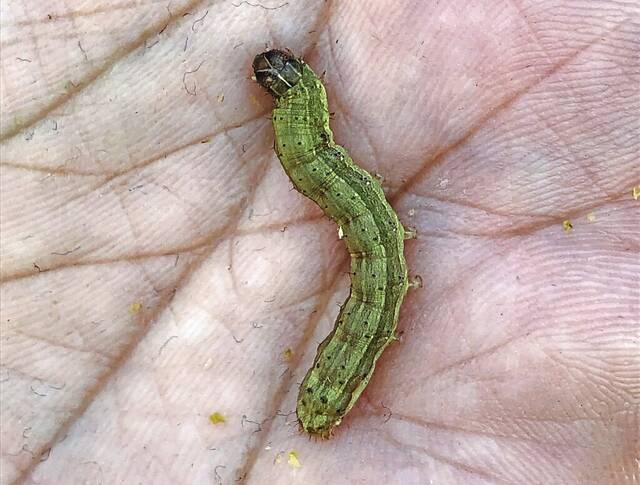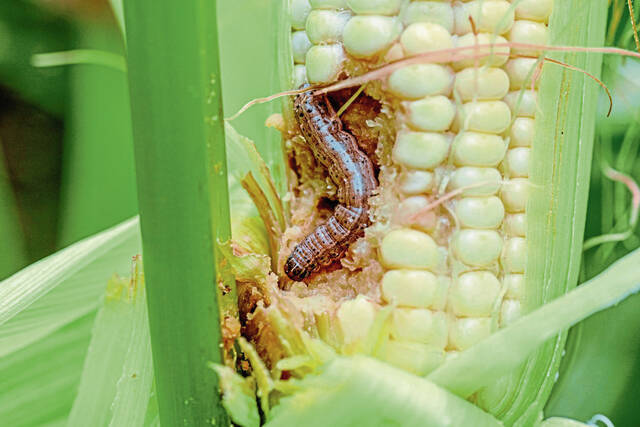Armyworms wreak havoc on lawns, crops in 'unprecedented' outbreak
Ben McGraw, an associate professor of turfgrass science at Pennsylvania State University, surveyed dead turf on a Pennsylvania golf course Friday.
The turf recently had been attacked by fall armyworms.
The moth larvae, which are known for destroying grass, turf and an array of crops, have been wreaking havoc during an “unprecedented” outbreak, said John Tooker, professor of entomology in Penn State’s College of Agricultural Sciences.
”I’ve never seen anything like it,” said Tooker, who also serves as a Penn State Extension field crop entomologist.
Fall armyworms — which are slightly different from true armyworms, which cause similar problems in the region in the spring — spend the winter months on the Gulf Coast, in Texas and Florida, Tooker said. In the spring and summer months, they migrate north, spend the warmer months in northern parts of the country and then return to the south in the fall.
“While it’s here, it does its damage,” Tooker said.
This year’s fall armyworm outbreak spans from as far south as Kentucky to as far north as Ontario, Tooker said, adding that the species, which is native to America, also has invaded China and Africa.
The armyworms, which can grow up to an inch and a half, vary in color, ranging from black to green. They usually have lines on their sides and what appear to be black bumps on their backs. Their most identifying feature, Tooker said, is a light-colored inverted ‘Y’ on their heads.
Fall armyworms aren’t picky eaters. Tooker said they’ve been known to eat hay, alfalfa, soybeans, corn and grass, among other plants.
They’re often particularly problematic for sweet corn growers, because they bore into ears of corn to feed on the developing kernels, Tooker said.
“They’re called armyworms because they kind of march en masse. Once they’re done with, say, a hayfield, if there’s a small grain field nearby, or a pasture nearby, or a residential lawn nearby, they’ll march over to that and start feeding again,” Tooker said. “It’s quite a phenomenon.”
They’re harmless to pets and people, Tooker said, but he’s seen them decimate crops and lawns.
“I’ve talked to farmers who have entire fields that are entirely brown now because the caterpillars ate every piece of grass there,” he said.
Carol Rhodes, general manager at Steel City Landscape, said the Pittsburgh-based lawn care company also has seen the armyworms causing issues this year.
The outbreak seemed to heighten about two weeks ago, Tooker said, but it should be winding down soon.
“What we saw as far as damage in the state will probably not get any worse,” McGraw said, explaining the fall armyworms in the area seem to be reaching full size and soon will return to the south as temperatures begin to cool. “I think it will start to resolve itself pretty quickly.”
Though Pennsylvania witnessed rampant turf loss and crop damage, McGraw said southern states tend to get hit harder. He noted these large-scale outbreaks are rare for Pennsylvania — so there’s typically no need to worry about taking preventative measures to keep the army of larvae out of yards or fields.
Insecticides can kill them off if they do begin an infestation, he said.
There are an array of insecticide options — with varying levels of toxicity and compatibility with specific plants — that can combat the armyworms, Tooker said, adding that anyone impacted should reach out to local experts, such as those at Penn State Extension, for help.
Yards and turf likely will recover well after a fall armyworm attack, McGraw said.
“From the turf standpoint, the home lawn standpoint, recovery is pretty good, even though they consume everything from the top down,” he said. “Unless you just recently seeded your lawn, I think recovery outlook is pretty good.”
Julia Felton is a TribLive reporter covering Pittsburgh City Hall and other news in and around Pittsburgh. A La Roche University graduate, she joined the Trib in 2020. She can be reached at jfelton@triblive.com.
Remove the ads from your TribLIVE reading experience but still support the journalists who create the content with TribLIVE Ad-Free.



